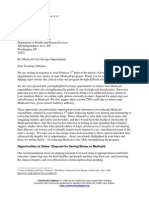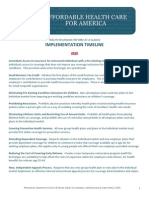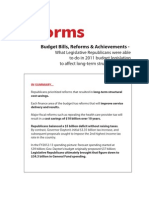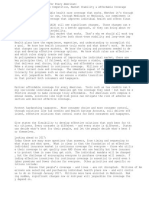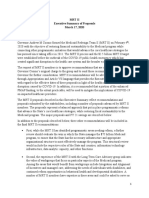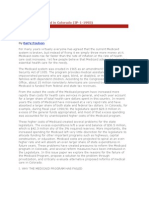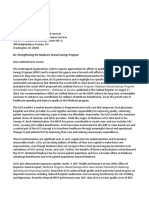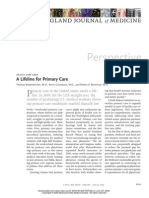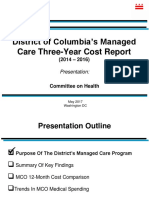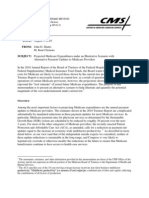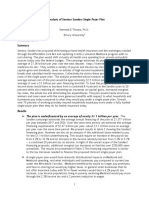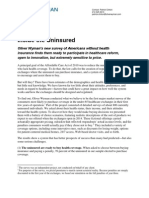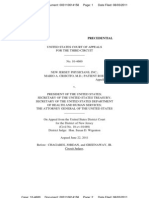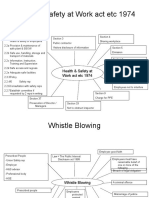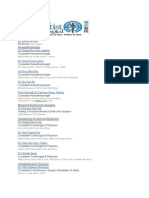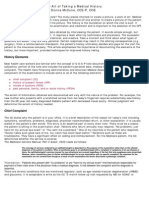Professional Documents
Culture Documents
Fact Sheet - Health Care - FINAL
Uploaded by
sarahkliffOriginal Description:
Copyright
Available Formats
Share this document
Did you find this document useful?
Is this content inappropriate?
Report this DocumentCopyright:
Available Formats
Fact Sheet - Health Care - FINAL
Uploaded by
sarahkliffCopyright:
Available Formats
Living Within Our Means and Investing in the Future: The Presidents Plan for Economic Growth and
Deficit Reduction Health Care
The Presidents Plan for Economic Growth and Deficit Reduction lives up to a simple idea: as a Nation, we can live within our means while still making the investments we need to prosper from a jobs bill that is needed right now to long-term investments in education, innovation, and infrastructure. It follows a balanced approach: asking everyone to do their part, so no one has to bear a disproportionate share of the burden. And it says that everyone including millionaires and billionaires must pay their fair share. Pursuing a balanced approach to deficit reduction is critical to being able to keep our promises made to all Americans. In pursuit of that goal, the President signed into law the Affordable Care Act which not only eliminated insurance company abuses and expanded access to health insurance to tens of millions of Americans, but also took important steps to reduce health care cost growth for future years. Ensuring that Medicare and Medicaid remain strong for the future requires that we take additional steps. The Affordable Care Act was an historic step toward getting health care costs under control, but more needs to be done to protect its solvency as demographics change and costs continue to rise. We can do this without undermining the fundamental compact these programs represent. The President will veto any bill that takes one dime from the Medicare benefits seniors rely on without asking the wealthiest Americans and biggest corporations to pay their fair share. To reduce the deficit and ensure the long-term sustainability of Medicare and Medicaid, the plan includes $320 billion in health savings over the next decade. Due to the structural nature of the reforms, health savings are projected to grow to over $1 trillion in the second decade. The $248 billion in Medicare savings extend the life of the Medicare Trust Fund by roughly three years. The $73 billion in Medicaid and other health program savings include phased-in reforms and targeted savings and flexibility for States. The Presidents proposals: Create payment incentives for skilled nursing facilities to improve their care to prevent avoidable hospital readmissions. Include incentives for people with Medicare to choose high-value health services. Reform Medicare payments to better align with patient care costs. Accelerate the availability of lower-cost generic drugs. Take steps to make Medicaid more efficient, accountable, and flexible.
These proposals are presented in the context of a baseline that assumes legislative action to permanently prevent current-law reductions in Medicare physician payment rates, consistent with the Administrations commitment to fix the sustainable growth rate policy in a fiscally responsible way. Specifically, the Administration proposes to: Improve access to affordable generics and lower Federal Employees Health Benefits (FEHB) drug costs: The package includes proposals designed to improve access to affordable
medications by prohibiting pay for delay agreements to increase the availability of generic drugs and biologics; reducing the exclusivity period for brand name biologics; streamlining FEHB pharmacy contracting. Strengthen Medicare by cutting waste, fraud, and improper payments. Waste, fraud, and abuse in any government program is unacceptable in this fiscal environment and a needless drain on Medicare. To ensure that Medicare dollars are being spent prudently, the Administration proposes several policies, including recovering erroneous payments made to insurers participating in Medicare Advantage; dedicating penalties for failure to use electronic health records toward deficit reduction; updating Medicare payments to more appropriately account for utilization of advanced imaging; and requiring prior authorization for advanced imaging. These proposals would save approximates $5 billion over the next 10 years. Create Incentives for Use of High-Value Services. The plan includes targeted financial incentives to encourage new Medicare beneficiaries (not seniors currently on Medicare), starting in 2017, to use high-value services. Similar policies have been recommended by experts as a way to improve program performance in the long run and lower overall costs to the system. They would: Modify Medicare Part B deductible for new beneficiaries. To encourage beneficiaries to seek high-value health care services, the Administration proposes to apply a $25 increase to the Part B deductible in 2017, 2019, and 2021 for new beneficiaries. This proposal will save approximately $1 billion over 10 years. Introduce home health cost-sharing for new Medicare beneficiaries. This proposal would create a home health copayment of $100 per home health episode, applicable for episodes with five or more visits not preceded by a hospital or other inpatient post-acute care stay. This policy would only apply to new beneficiaries beginning in 2017 and is estimated to save approximately $0.4 billion over 10 years. Encourage efficient supplemental coverage choices for new beneficiaries through a Medicare Part B premium surcharge. To encourage more-efficient health care choices, the Administration proposes a Part B premium surcharge equivalent to about 15 percent of the average Medigap premium for new beneficiaries that purchase Medigap policies with particularly low cost-sharing requirements, starting in 2017. This proposal will save approximately $2.5 billion over 10 years.
Reduce certain Medicare special payments: Medicare historically has supplemented its payments for services to maintain the robustness of the provider network. These payments have helped to offset bad debt that providers accrue, support the extra costs of training physicians, and protect the viability of rural providers. These goals are important, but evidence suggests that some rates are too high. The plan includes proposals to: Align Medicare policy with private sector practice in coverage of bad debts. For most eligible provider types, Medicare currently reimburses generally 70 percent of bad debts resulting from beneficiaries non-payment of deductibles and copayments after
providers have made reasonable efforts to collect the unpaid amounts. This proposal will align Medicare policy more closely with private sector standards by reducing bad debt payments to 25 percent for all eligible providers over three years starting in 2013. This will save approximately $20 billion over 10 years. Reduce graduate medical education payments to better align with patient care costs. Medicare compensates teaching hospitals for the indirect costs stemming from inefficiencies created from residents learning by doing. The Medicare Payment Advisory Commission (MedPAC) has determined that these Indirect Medical Education (IME) add-on payments are significantly greater than the additional patient care costs that teaching hospitals experience. This proposal would reduce the IME adjustment by 10 percent beginning in FY 2013, and save approximately $9 billion over 10 years. Better align Medicare payments to rural providers with the cost of care. Medicare makes a number of special payments to account for the unique challenges of delivering medical care to beneficiaries in rural areas. But these programs have expanded so that they now include one-third of all hospitals and have exceeded the scope and purpose for which they were created. The Administration proposes to improve the consistency of payments across hospital types, provide incentives for efficient delivery of care, and eliminate higher than necessary reimbursement. Together, these rural proposals will save approximately $6 billion over 10 years.
Encourage efficient post-acute care. Medicare covers services in skilled nursing facilities (SNFs), long-term care hospitals (LTCHs), inpatient rehabilitation facilities (IRFs) and home health. Over the years, expenditures for these services have increased dramatically, and payments in excess of the costs of providing high quality and efficient care place a drain on Medicare. Moreover, payment for the same service varies by provider type. Recognizing the importance of these services, the Administration proposes the following policies that will save $42 billion over 10 years and improve the quality of care: Adjust payment updates for certain post-acute care providers. This proposal would gradually realign payments with costs through adjustments to payment rate updates in 2014 through 2021 for these providers. Equalize payments for certain conditions. This policy would reduce the differences in payment by IRFs and SNFs for treatment of specified conditions to encourage care in the most clinically appropriate setting beginning in FY 2013. Encourage appropriate use of inpatient rehabilitation hospitals. This proposal would update compliance requirements to better ensure that the higher IRF payments apply to cases requiring this level of care. Adjust SNF payments to reduce hospital readmissions. Nearly 14 percent of Medicare patients that are discharged from a hospital to a SNF are readmitted to the hospital for conditions that could have been avoided. To promote high quality care in SNFs, this
proposal reduces SNF payments by up to 3 percent beginning in FY 2015 for facilities with high rates of care-sensitive, preventable hospital readmissions. Align Medicare drug payment policies. There are substantial differences in rebate amounts and net prices paid for brand name drugs under Medicare versus Medicaid, with Medicare receiving significantly lower rebates and paying higher prices. Moreover, Medicare per capita spending in Part D is growing significantly faster than spending in Parts A or B. This proposal would allow Medicare to benefit from the same rebates that Medicaid receives for brand name and generic drugs provided to beneficiaries who receive the Medicare Low-Income Subsidy beginning in 2013. This option is estimated to save $135 billion over 10 years. Increase Medicare Parts B and D premiums for higher-income beneficiaries. Under Medicare Parts B and D, certain higher-income beneficiaries must pay higher premiums. Beginning in 2017, the Administration proposes to increase income-related premiums under Medicare Parts B and D. It also extends the freeze in the income thresholds until 25 percent of beneficiaries pay the higher premium. This proposal will save approximately $20 billion over 10 years. Strengthen the Independent Payment Advisory Board (IPAB): The proposal would strengthen IPAB by reducing its growth rate target (from GDP per capita plus 1 percent to plus 0.5 percent). It would also provide additional tools like the ability to consider value-based benefit design and enforcement mechanisms. IPAB will continue to be prohibited from making recommendations to ration care, increase beneficiary premiums or cost sharing, or restrict benefits. Reduce fraud, waste, and abuse in Medicaid. Medicaid funds should not be wasted on fraudulent claims, abuses of the rules, or general waste in implementing the program. The following policies will save $1.4 billion over the next 10 year while reducing waste, fraud, and abuse: Strengthen third-party liability for Medicaid beneficiary claims. Require manufacturers that improperly report items for Medicaid drug coverage to fully repay States. Track high prescribers and utilizers of prescription drugs in Medicaid. Enforce Medicaid drug rebate agreements. Increase penalties on drug manufacturers for fraudulent non-compliance with Medicaid drug rebate agreements. Require drugs to be properly listed with the FDA to receive Medicaid coverage. Prohibit States from using Federal funds as the State share of Medicaid or CHIP, unless specifically authorized by law.
Increase State flexibility and streamline oversight in Medicaid: This proposal would give State the flexibility to use a benchmark benefits plan for optional populations with income above 133 percent of the Federal poverty line. It also would consolidate and streamline redundant error rate programs.
Accelerate State innovation waivers: This proposal empowers States to develop their own strategies to ensure their residents have the same access to high quality, affordable health care as would be achieved under the Affordable Care Act. It does so by making the health reform laws State Innovation Waivers available starting in 2014, three years earlier than under the current law. These State strategies would provide affordable insurance coverage to at least as many residents as without the waiver, and must not increase the Federal deficit. Limit Medicaid provider taxes. Many States impose taxes on health care providers to help finance the State share of Medicaid program costs. While often a source of real financing, some States increase payments to those same providers in the amount of the revenue they receive in taxes, drawing Federal Medicaid matching payments with little benefit to the low-income populations the program serves. The Administration proposes to limit these types of State financing practices by phasing down, but not eliminating, Medicaid provider taxes. By delaying the effective date until 2015, the proposal gives States time to prepare for the change. This proposal is projected to save $26.3 billion over 10 years. Simplify Federal Medicaid payment formulas for States. Under current law, States face a patchwork of different Federal payment contributions for individuals eligible for Medicaid and the Childrens Health Insurance Program (CHIP). Beginning in 2017, this proposal would replace the currently complicated formulas with a single matching rate specific to each State based on enrollment starting in 2014 that automatically increases if a recession forces enrollment and State costs to rise. The full Federal funding for people gaining Medicaid coverage in 2014 through 2016 would be preserved. The proposal may improve coverage since it gives States a financial incentive to enroll newly eligible individuals for Medicaid early. The more newly eligible people they enroll in the first year or so of the program, the higher the blended matching rate will be in 2017. This proposal is projected to save $14.9 billion over 10 years. Reduce unnecessary taxpayer Medicaid spending on overpayments for medical equipment. This proposal limits Federal reimbursement for a States Medicaid spending on certain durable medical equipment services to what Medicare would have paid in the same State for the same services. This proposal is projected to save the Federal government $4.2 billion and State governments more than $3 billion over 10 years. Re-base Medicaid formula for supporting hospitals that serve low-income Americans in 2021. Supplemental disproportionate share hospital payments are intended to help support hospitals that provide care to disproportionate numbers of low-income and uninsured individuals. The Administration proposes to better align these future Medicaid supplemental payments to hospitals with reduced levels of uncompensated care. This proposal is projected to save $4.1 billion over 10 years. Better target Medicaid resources by updating income definition. Starting in 2014, eligibility for Exchange premium tax credits and cost sharing reductions, Medicaid, and CHIP will be determined based on an individuals or familys modified adjusted gross income (MAGI). The Administration proposes to amend this definition for purposes of health insurance assistance programs to include total Social Security benefits, consistent with current Medicaid practice,
which will enable States to better target those in need. This proposal is projected to save $14.6 billion over 10 years. Prioritize prevention and public health fund investment: The Administration proposals to improve its targeting of the Prevention and Public Health Fund, maintaining $13.8 billion for effective, evidence-based activities, while reducing the Fund by $3.5 billion over 10 years. Pursue balanced deficit reduction to prevent drastic cuts. We have little doubt that some of these proposals will not be popular with all those that they affect. These are tough choices that we had to make -- and some of these changes are those that we would not make if it were not for our fiscal situation. But we are all in this together, and all of us must contribute to getting our economy moving again and on a firm fiscal footing. If we all dont pitch in, we know what happens if we try to do this much deficit reduction without a balanced approach because the congressional Republicans have proposed to do that. Millionaires and big corporations keep all their special tax breaks and tax cuts while there are severe cuts in programs we need to grow and prosper on which many Americans rely. For instance, under their budget, Medicare would end as we know it. It would be turned into a voucher program, and since that voucher would not keep pace with health care costs, a typical 65-year-old in the first year of this new arrangement would see her out-of-pocket costs increase by $6,400. And their proposed restructuring of Medicaid would cut funding by a third and could leave an estimated 50 million Americans in need without health insurance. We believe the Presidents plan is the most fair and effective way to keep the promises made to all Americans while achieving the deficit reduction needed to win the future.
You might also like
- Medicare Revolution: Profiting from Quality, Not QuantityFrom EverandMedicare Revolution: Profiting from Quality, Not QuantityNo ratings yet
- Textbook of Urgent Care Management: Chapter 34, Engaging Accountable Care Organizations in Urgent Care CentersFrom EverandTextbook of Urgent Care Management: Chapter 34, Engaging Accountable Care Organizations in Urgent Care CentersNo ratings yet
- Community Catalyst 2/25/11 Letter To HHS Secretary With Medicaid Cost-Savings SuggestionsDocument7 pagesCommunity Catalyst 2/25/11 Letter To HHS Secretary With Medicaid Cost-Savings SuggestionsSandy CohenNo ratings yet
- Prepplan PDFDocument12 pagesPrepplan PDFCommittee For a Responsible Federal BudgetNo ratings yet
- The Next Steps For Medicare Reform, Cato Policy AnalysisDocument24 pagesThe Next Steps For Medicare Reform, Cato Policy AnalysisCato InstituteNo ratings yet
- Mac Guineas Testimony Medicare Reform 12oct11Document12 pagesMac Guineas Testimony Medicare Reform 12oct11Committee For a Responsible Federal BudgetNo ratings yet
- Cost Sharing MotDocument9 pagesCost Sharing MotCommittee For a Responsible Federal BudgetNo ratings yet
- Ib 33 PDFDocument12 pagesIb 33 PDFLatinos Ready To VoteNo ratings yet
- HCRprovisions - Older Adults 3-30-10Document6 pagesHCRprovisions - Older Adults 3-30-10hcreformNo ratings yet
- Implementation Timeline: P C W & M, E & C, E & L, A 2, 2010Document7 pagesImplementation Timeline: P C W & M, E & C, E & L, A 2, 2010Lydia GaltonNo ratings yet
- "Bundling" Payment For Episodes of Hospital CareDocument29 pages"Bundling" Payment For Episodes of Hospital CareCenter for American Progress100% (1)
- Obama's Proposed Cuts 2011-14Document10 pagesObama's Proposed Cuts 2011-14RJohansen1No ratings yet
- Health System Reform Short SummaryDocument11 pagesHealth System Reform Short SummarySteve LevineNo ratings yet
- Medicare Is Not BankruptDocument3 pagesMedicare Is Not BankruptMustaffah KabelyyonNo ratings yet
- 2011 Budget ReformsDocument8 pages2011 Budget ReformsSenatorNienowNo ratings yet
- Cost Control in Health Care......................................Document11 pagesCost Control in Health Care......................................Rifat ParveenNo ratings yet
- AV Comment Letter On 2024 MA Advance Notice FINALDocument5 pagesAV Comment Letter On 2024 MA Advance Notice FINALArnold VenturesNo ratings yet
- Arnold Ventures Comment On CY2024 MPFS RuleDocument9 pagesArnold Ventures Comment On CY2024 MPFS RuleArnold VenturesNo ratings yet
- AHIPDocument5 pagesAHIPPeter SullivanNo ratings yet
- Executive Summary of ProposalsDocument15 pagesExecutive Summary of ProposalsJonathan LaMantia100% (1)
- Managed Care NPRM 09 2015Document3 pagesManaged Care NPRM 09 2015api-293754603No ratings yet
- SPR BHB Funding Fact Sheet May 2019Document5 pagesSPR BHB Funding Fact Sheet May 2019BernewsAdminNo ratings yet
- Privatizing Medicaid in ColoradoDocument7 pagesPrivatizing Medicaid in ColoradoIndependence InstituteNo ratings yet
- What Is Congress Considering?Document3 pagesWhat Is Congress Considering?brendawilliamsNo ratings yet
- Health Reform Act Section AnalysisDocument8 pagesHealth Reform Act Section AnalysisKyle BligenNo ratings yet
- Letter of Support For ACOs and MSSP NPRM Sign On 09202018Document3 pagesLetter of Support For ACOs and MSSP NPRM Sign On 09202018HLMeditNo ratings yet
- 2015 Health Care Providers Outlook: United StatesDocument5 pages2015 Health Care Providers Outlook: United StatesEmma Hinchliffe100% (1)
- Bodenheimer PrimCareDocument4 pagesBodenheimer PrimCareJaume SanahujaNo ratings yet
- MCO Three-Year Cost ReportDocument28 pagesMCO Three-Year Cost Reporttinareedreporter100% (1)
- Health Affairs Medicare's New Physician Payment System PDFDocument7 pagesHealth Affairs Medicare's New Physician Payment System PDFiggybauNo ratings yet
- Department of Health and Human Services: The President's 2009 Budget WillDocument6 pagesDepartment of Health and Human Services: The President's 2009 Budget Willapi-19777944No ratings yet
- Introduction To Us Healthcare System: Trends in Premiums and Cost Sharing and Its Reasons and ImplicationsDocument9 pagesIntroduction To Us Healthcare System: Trends in Premiums and Cost Sharing and Its Reasons and ImplicationsShruti SinghNo ratings yet
- Bennet-Kaine Medicare-X Choice Act SummaryDocument1 pageBennet-Kaine Medicare-X Choice Act SummaryU.S. Senator Michael F. BennetNo ratings yet
- Mar12 EntireReportDocument443 pagesMar12 EntireReportcaemonNo ratings yet
- Stimulus 101: Understanding The HITECH Act and Meaningful UseDocument4 pagesStimulus 101: Understanding The HITECH Act and Meaningful UseConner FitzpatrickNo ratings yet
- 2018-19 SFY Health and Mental Hygiene Budget HighlightsDocument7 pages2018-19 SFY Health and Mental Hygiene Budget HighlightsNew York SenateNo ratings yet
- Centers For Medicare and Medicaid Services: Term PaperDocument20 pagesCenters For Medicare and Medicaid Services: Term PaperMatt SzybalskiNo ratings yet
- International Social Welfare ProgramsDocument10 pagesInternational Social Welfare ProgramsZaira Edna JoseNo ratings yet
- Medicare Part DDocument2 pagesMedicare Part DArnold VenturesNo ratings yet
- ACOS An Eye On Washington Quarterly (SGR)Document3 pagesACOS An Eye On Washington Quarterly (SGR)acosurgeryNo ratings yet
- A New Definition' For Health Care Reform: James C. Capretta Tom MillerDocument57 pagesA New Definition' For Health Care Reform: James C. Capretta Tom MillerFirhiwot DemisseNo ratings yet
- IRG Health Care ReportDocument57 pagesIRG Health Care ReportAnthony DaBruzziNo ratings yet
- Healthy California Act AnalysisDocument8 pagesHealthy California Act AnalysisDylan MatthewsNo ratings yet
- The Establishment Strikes Back: Medical Savings Accounts and Adverse Selection, Cato Briefing PaperDocument7 pagesThe Establishment Strikes Back: Medical Savings Accounts and Adverse Selection, Cato Briefing PaperCato InstituteNo ratings yet
- Projected Medicare Expenditures Under An Illustrative Scenario With Alternative Payment Updates To Medicare ProvidersDocument18 pagesProjected Medicare Expenditures Under An Illustrative Scenario With Alternative Payment Updates To Medicare ProvidersTed OkonNo ratings yet
- September 21, 2009 The Honorable Max Baucus Chairman Senate FinanceDocument13 pagesSeptember 21, 2009 The Honorable Max Baucus Chairman Senate Financeapi-26254299No ratings yet
- CaidActuarial Report 2011Document59 pagesCaidActuarial Report 2011QMx2014No ratings yet
- EHRIP Eligible Professionals Tip Sheet PDFDocument4 pagesEHRIP Eligible Professionals Tip Sheet PDFdnice408No ratings yet
- Do You Know The Fair Market Value of Quality?: Jen JohnsonDocument8 pagesDo You Know The Fair Market Value of Quality?: Jen JohnsonG Mohan Kumar100% (1)
- FEHB Program Carrier Letter: All CarriersDocument8 pagesFEHB Program Carrier Letter: All CarriersleejolieNo ratings yet
- Letter To GovernorsDocument4 pagesLetter To GovernorsSarah KliffNo ratings yet
- Medicare Medicaid Reimbursement ProcessesDocument10 pagesMedicare Medicaid Reimbursement ProcessesRuthNo ratings yet
- Mississippi Hospital Association's Comment On Inpatient Psychiatric Rate Update Proposed by CMSDocument6 pagesMississippi Hospital Association's Comment On Inpatient Psychiatric Rate Update Proposed by CMSJonathan AllenNo ratings yet
- Vermont Report Recommends Single Payer System - Presentation To The State LegislatureDocument33 pagesVermont Report Recommends Single Payer System - Presentation To The State LegislatureRich ElmoreNo ratings yet
- Perspective: New England Journal MedicineDocument3 pagesPerspective: New England Journal MedicineAllen ZhuNo ratings yet
- HCM 400 Forces Impact HealthcareDocument9 pagesHCM 400 Forces Impact HealthcareEunice AppiahNo ratings yet
- The Impact of The Economic Recovery Act of 2009 On HealthcareDocument31 pagesThe Impact of The Economic Recovery Act of 2009 On Healthcareasg_akn8335No ratings yet
- Healthcare Inc. A Better Business ModelDocument13 pagesHealthcare Inc. A Better Business ModelrangababNo ratings yet
- Kenneth Thorpe's Analysis of Bernie Sanders's Single-Payer Proposal.Document7 pagesKenneth Thorpe's Analysis of Bernie Sanders's Single-Payer Proposal.Dylan Matthews57% (7)
- Medicaid Expansion in Missouri: Benefits Outweigh CostsDocument8 pagesMedicaid Expansion in Missouri: Benefits Outweigh CostsLilMsBaxNo ratings yet
- HHS V Florida PetitionDocument44 pagesHHS V Florida PetitionsarahkliffNo ratings yet
- Stearns Planned ParenthoodDocument6 pagesStearns Planned ParenthoodsarahkliffNo ratings yet
- Health Leadership CouncilDocument5 pagesHealth Leadership CouncilsarahkliffNo ratings yet
- 4 - Aff Jennie McCormackDocument6 pages4 - Aff Jennie McCormacksarahkliffNo ratings yet
- Inside The UninsuredDocument6 pagesInside The UninsuredsarahkliffNo ratings yet
- CA3 Opinion (New Jersey Physicians) (8.3.11)Document15 pagesCA3 Opinion (New Jersey Physicians) (8.3.11)sarahkliffNo ratings yet
- PE 11 Modules For First Semester 1 1Document30 pagesPE 11 Modules For First Semester 1 1Joseph LapsoNo ratings yet
- Changing Lifestyle BehaviorDocument23 pagesChanging Lifestyle BehaviorVincent QuitorianoNo ratings yet
- H&S at Work act 1974 dutiesDocument44 pagesH&S at Work act 1974 dutiesSardar Majid80% (5)
- SHS Applied - Inquiries, Investigations and Immersions CG - Spideylab - Com - 2017Document4 pagesSHS Applied - Inquiries, Investigations and Immersions CG - Spideylab - Com - 2017Lexis Anne BernabeNo ratings yet
- Mid-Term Presentation OutlineDocument16 pagesMid-Term Presentation Outlineapi-526664901No ratings yet
- Office: of The SecretaryDocument9 pagesOffice: of The SecretaryChristian Christopher LopezNo ratings yet
- Viral Exanthems and EnanthemsDocument2 pagesViral Exanthems and Enanthemsclark146No ratings yet
- Final Co-Orporate Presentation CDDocument33 pagesFinal Co-Orporate Presentation CDJoyeeta BanerjeeNo ratings yet
- Measuring Women's Quality of Life During Pregnancy: Kontakt November 2017Document7 pagesMeasuring Women's Quality of Life During Pregnancy: Kontakt November 2017DrAnisha PatelNo ratings yet
- Exam Anxiety in School Students: Muskan Agarwal 1-B Enroll No.-A1506920362 Faculty Guide - Dr. Anika MaganDocument16 pagesExam Anxiety in School Students: Muskan Agarwal 1-B Enroll No.-A1506920362 Faculty Guide - Dr. Anika MaganMuskan AgarwalNo ratings yet
- IJM Safety Conference Paper Summarizes NADOPOD 2004 Reporting RegulationsDocument1 pageIJM Safety Conference Paper Summarizes NADOPOD 2004 Reporting RegulationsKay AayNo ratings yet
- Missed Nursing Care in Pediatric and Neonatal Care Settings: An Integrative ReviewDocument2 pagesMissed Nursing Care in Pediatric and Neonatal Care Settings: An Integrative ReviewMikaela Gabrielle GERALINo ratings yet
- American College of Women's Health PhysiciansDocument16 pagesAmerican College of Women's Health PhysiciansSex & Gender Women's Health CollaborativeNo ratings yet
- Pengaruh Kompres Dingin Terhadap Penurunan Nyeri Persalinan Kala I Pada Ibu Bersalin Di Wilayah Kerja Puskesmas Batu Aji Kota Batam TAHUN 2018Document5 pagesPengaruh Kompres Dingin Terhadap Penurunan Nyeri Persalinan Kala I Pada Ibu Bersalin Di Wilayah Kerja Puskesmas Batu Aji Kota Batam TAHUN 2018Arisa CaNo ratings yet
- Case Report: Scleredema Diabeticorum in A Patient With Type 2 Diabetes MellitusDocument5 pagesCase Report: Scleredema Diabeticorum in A Patient With Type 2 Diabetes MellitusKerin ArdyNo ratings yet
- Proposal Security Integrated SystemDocument46 pagesProposal Security Integrated SystemIndra Jaya100% (1)
- Hospital AdventistDocument6 pagesHospital AdventistGina Hong HongNo ratings yet
- The Art of Taking A Medical HistoryDocument4 pagesThe Art of Taking A Medical HistorypuneetNo ratings yet
- Notice: Program Exclusions ListDocument4 pagesNotice: Program Exclusions ListJustia.comNo ratings yet
- Miracle MineralsDocument32 pagesMiracle MineralsTURGIS100% (11)
- Autoimmune Encephalitis Syndromes With Antibodies - UpToDateDocument1 pageAutoimmune Encephalitis Syndromes With Antibodies - UpToDateSamNo ratings yet
- Antibiotik Dan Antiseptik Saluran KemihDocument14 pagesAntibiotik Dan Antiseptik Saluran KemihPuterinugraha Wanca ApatyaNo ratings yet
- Menstrual DisordersDocument45 pagesMenstrual DisordersMegat Mohd Azman Adzmi100% (1)
- Normal LabourDocument90 pagesNormal LabourshawishnsNo ratings yet
- Myasthenia Gravis NCPDocument1 pageMyasthenia Gravis NCPCzarina0% (1)
- June Workout ScheduleDocument5 pagesJune Workout ScheduleJaneNo ratings yet
- HIST103 Syll Fall 2010Document6 pagesHIST103 Syll Fall 2010gae24341No ratings yet
- Hospital ExamplesDocument10 pagesHospital ExamplesArmand Kyle AbadNo ratings yet
- Spars Pandemic Scenario (1) (01 38)Document38 pagesSpars Pandemic Scenario (1) (01 38)YuliayAngel NavarroNo ratings yet
- Antimaleria Drug ModelsDocument33 pagesAntimaleria Drug ModelsMehari AsratNo ratings yet


